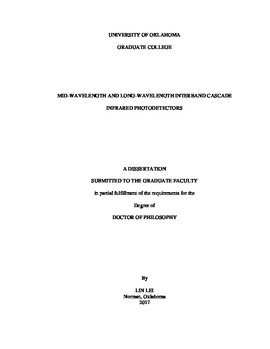| dc.contributor.advisor | Yang, Rui Q. Jr | |
| dc.contributor.author | Lei, Lin Jr | |
| dc.date.accessioned | 2017-10-31T21:36:43Z | |
| dc.date.available | 2017-10-31T21:36:43Z | |
| dc.date.issued | 2017-10-30 | |
| dc.identifier.uri | https://hdl.handle.net/11244/52405 | |
| dc.description.abstract | Interband cascade (IC) devices are a family of infrared optoelectronic devices that includes interband cascade lasers (ICLs), interband cascade infrared photodetectors (ICIPs) and interband cascade infrared thermophotovoltaics (ICTPVs). They are unique due to their multiple-stage architecture based on type-II heterostructures. In IC devices, the carrier transport is rectified with two unipolar barriers (injectors), namely the electron barrier (hole injector) and hole barrier (electron injector). The series connection between cascade stages is realized by employing the type-II broken-gap alignment between InAs and GaSb layers. While a conventional single stage detector is limited by the short diffusion length and carrier lifetime at high temperatures and long wavelengths, an ICIP with a series of thin discrete absorbers can circumvent these limitations with high device performance. Although the responsivity of ICIPs is reduced by the thin absorbers, noise is also reduced significantly by the series connected cascade stages so that a large signal to noise ratio is retained. Most of the interest for IR detector applications is focused on the mid-wavelength (MW) infrared (IR) and long-wavelength (LW) IR bands. However, most of them require a cooling system to achieve high device performance. ICIPs are one of the most promising candidates for meeting the high-performance and uncooled requirements of these applications.
MW ICIPs based on InAs/GaSb type-II superlattice (T2SL) and bulk GaInAsSb absorbers are discussed in detail. High temperature operation and high device performance are demonstrated with Johnson-noise limited detectivities over 1.0×10^9 cmˑHz^1/2/W at 300 K.
LW ICIPs with current-matching and non-current matching architectures were systematically studied. These ICIPs are capable of operating at high temperatures up to 340 K. They exhibited a high device performance with a detectivity (D*) higher than 1.0×10^9 and 1.0×10^8 cmˑHz^1/2/W at 200 and 300 K, respectively. While current-matching is necessary for maximizing photon absorption to achieve optimal responsivity, the lower responsivity in the non-current matched ICIPs is attributed to light attenuation in the optically deeper stages. Meanwhile, the responsivity in the non-current matched ICIPs is enhanced by the significantly higher electrical gain, along with the much higher resistances, so that their device performance is comparable or even slightly higher than the current matched ICIPs.
Multi-stage ICIPs show superior performance over conventional one-stage detectors at high temperatures in both the MWIR and LWIR regions. The presence of high electrical gain in the both MW and LW ICIPs may be related to two mechanisms: one is the photoconductive gain due to a shorter transit time than carrier lifetime, the other is the compensation of dark current to maintain current continuity.
The observed multiple negative differential conductance (NDC) features in the LW ICIPs at high temperatures are related to the sequential turn-off of intraband tunneling of minority carriers through the electron barriers. Five sets of ICIPs with various structural details and carrier concentrations in the absorber were systematically studied to illustrate the underlying physics and demonstrate the mechanism for NDC. | en_US |
| dc.language | en | en_US |
| dc.subject | infrared detectors | en_US |
| dc.subject | interband cascade | en_US |
| dc.subject | mid-wavelength and long wavelength | en_US |
| dc.subject | high operating temperature | en_US |
| dc.title | Mid-wavelength and long-wavelength interband cascade infrared photodetectors | en_US |
| dc.contributor.committeeMember | Santos, Michael Jr | |
| dc.contributor.committeeMember | Johnson, Matthew Jr | |
| dc.contributor.committeeMember | Mullen, Kieran Jr | |
| dc.contributor.committeeMember | Kao, Chung Jr | |
| dc.contributor.committeeMember | Sigmarsson, Hjalti Jr | |
| dc.date.manuscript | 2017-10-30 | |
| dc.thesis.degree | Ph.D. | en_US |
| ou.group | College of Engineering::Department of Engineering Physics | en_US |
| shareok.orcid | 0000-0001-6005-278 | en_US |
| shareok.nativefileaccess | restricted | en_US |
